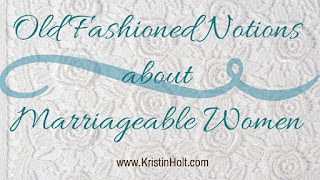
Marriage, Late 19th Century
As readers of American Historical Romance, we crave the rich details of yesteryear. How did gallant men go about proposing marriage? What wedding traditions were all the rage in America's Victorian Era? Were invitations engraved and sent by post?
Perhaps the better question for this 1888 "slice of life" is: "Again?" What part of "Marry me" requires an "again?"
Thrice?
This vintage newspaper article, published in The Times of Clay Center, Kansas (original to the Rome (N.Y.) Sentinel) on January 17, 1888. In order to assure easy reading (and help to today's search engines), I've carefully transcribed the article. A vintage image of this newspaper clipping follows.
MARRIED THREE TIMES.
-------------
A Young Couple Who Were Not Content with One Ceremony.
Nearly all classes of professional men have queer experiences, and clergymen are not excepted. One evening, some time since, says the Rome (N.Y.) Sentinel, the pastor of one of our city churches upon returning home from a sick call found three persons--a gentleman and two ladies--awaiting him in the parlor. The gentleman and one of his companions were quite young, while the other was far advanced in years. As the dominie entered the old lady immediately made known their business by starting that the young couple desired to be married. The minister replied that that was quite the proper thing to do, and proceeded to bring forth a number of books and documents. The young couple seemed somewhat embarrassed. The clergyman thinking that the novelty of the position had a depression effect upon them, assumed his brightest air, and, by pleasant remarks and cheerful conversation, sought to reassure the bashful swain and his sweetheart that the married state was not so bad as it had been painted from time to time by cross-grained old bachelors. Under the present Marriage law of the State a clergyman is required to propound numerous questions to parties desirous of being married, the answers to which must be kept on record. The clergyman smilingly remarked, as he spread the document on the table before him, that getting married nowadays was like a will or drawing up a deed, and told the couple that they must answer a great many questions.
"Yes," chimed in the old lady to her younger companions, "you must tell every little thing."
After a little hesitation the couple stated that they had been married before, and the officiating clergyman was the predecessor of the gentleman upon whom they were calling for the purpose of being reunited. Without questioning them further the clergyman found, upon making an examination of the records, that their statement was true. He was somewhat surprised, however, at finding opposite the record a memorandum to the effect that that was their second marriage. When questioned on this point the young people owned up that they had been married twice.
"Then why in the world do you desire to be married again? Isn't twice enough?" asked the minister.
They explained that the first marriage took place in a country village and was performed by a clergyman without the presence of witnesses. Not being satisfied with this, they were united the second time. The young lady had continued to reside at home and had never acquainted her parents or any one else of their marriage; it was a profound secret. The couple had said they were desirous of living together as husband and wife, but the young lady feared to break the news of their relations to her parents, as they might be provoked at the deception she had practiced. They thought the only way out of it was for them to be again married and present a new certificate. The clergyman told them that the presentation of a certificate signed at that time would be as much of a deception as in the other case and advised them to go home, break the news to the world and try to get along on the double marriage.
~ Source: The Times of Clay Center, Kansas on January 17, 1888
Here's the original image:
Moral of the Story
So this actually happened, right? Some young couple--a living, breathing, true-to-history couple showed up at this clergyman's home, yes?
Likely not.
Late nineteenth century newspapers often carried articles proposed as fact when in truth, they shaped and told stories about Victorian-era virtues and moral codes. Yes, no doubt many young couples kept secrets from their parents--a No No for the times. "Food for thought" includes the all-importance of marriage at the beginning of intimacies, integrity, propriety, purpose of witnesses, and likely many more.
Looking at this tale about marriage informs contemporary readers about what actually had to happen. It seems likely the minister had to ask questions that would reveal if the bride-elect or groom-elect had any legal reason they couldn't be wed (such as a prior marriage still in effect).

















No comments:
Post a Comment